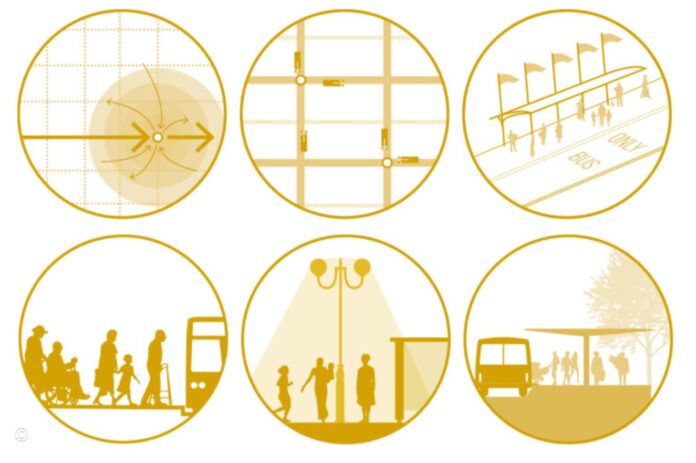1. “Stations are Gateways.”
The relationship vehicular traffic has with sidewalks and buildings is one point that should receive special attention when designing a bus stop or station. This is because the way a stop interacts with its environment determines whether or not it’s an appropriate access point to the transit system.
2. “Facilitate Movement, Ease Interactions.”
The role that public transport stations can play in a neighborhood goes much further than just being where people get on and off a bus. In fact, if the design and location of the stops are well planned, it is possible to reduce travel times and thus increase confidence in the transit system.
3. “In-lane Stops Save Time.”
Stops in bus-only lanes make it possible to reduce delays for the other traffic by concentrating stops in traffic flow to a single lane. This also offers an opportunity to create a safer space where passengers can board buses more calmly. They also contribute to condensing activity to a single point on the sidewalk without affecting the flow of pedestrians.
4. “Universal Design is Equitable Design.”
It’s possible to ensure that differently-abled passengers and people of any age can safely board buses if the bus stops’ designs are people-centered and accessible to all from the outset.
5. “Design for Safety.”
NACTO defines having traffic safe and socially safe pedestrian routes from places of origin to stops as an element that is “vital to achieving a safe [transportation] system.”
6. “Integrate Vehicle and Platform Design.”
Designing stops to be level with buses and the sidewalks is a basic feature so that boarding is first and foremost accessible and fast. This situation, which NACTO considers as a key part of any system, requires that they have a flexible design able to be used with different types of buses.
ANALYSIS:
With an interest in wanting to explore the spatial design of what a bus stop could potentially look like, I found this article to be particularly interesting. While some of the key takeaways seem obvious, I felt like the overall structure of keeping these 6 topics in mind with spatial planning to be insightful and important things to be mindful of if moving forward. One of the things I wouldn’t have even considered was number 6 and just that overall interaction with boarding and getting off a bus. Even for an able body person, the task of stepping off a bus and back onto a sidewalk can be jarring if you were to misstep. I believe something in regards to that overall interaction can be further looked at.
Gaete, Constanza Martínez. “6 Tips for Designing Accessible and Safe Bus Stops.” ArchDaily, ArchDaily, 27 Mar. 2017, https://www.archdaily.com/867962/6-tips-for-designing-accessible-and-safe-bus-stops.




